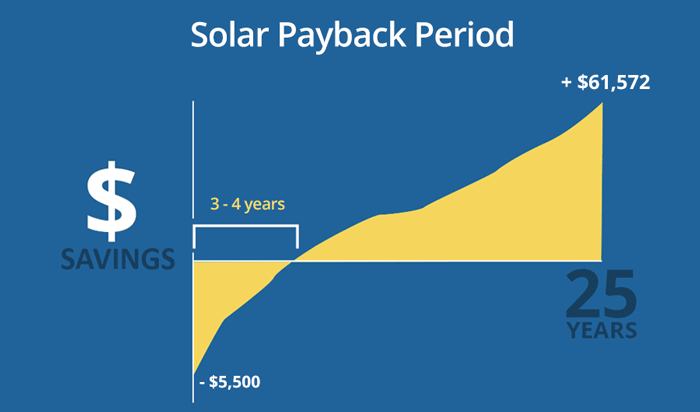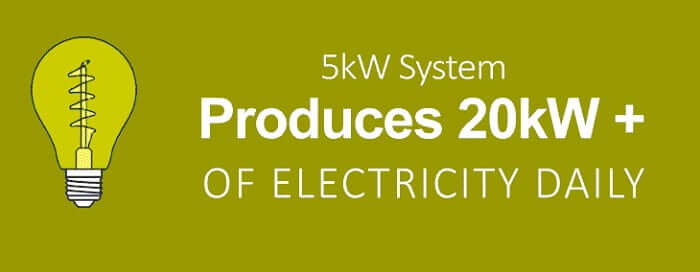Home Solar Payback Period
Solar Panel Payback Period
G’day! If you’re calling Australia home, odds are you’ve been toying with the idea of slapping some solar panels on your roof to tackle those electricity bills. Right now, let’s get stuck into a cracker of a topic – the solar payback period.
The average payback period for solar in Australia is 4 years. There are a few variables that determine this like system size, monthly usage and the amount of sunlight you get. The true range is 3 – 5 years with 4 years being the average.
Understanding how long it will take for that solar panel to pay itself back before you make the installation. Follow closely for all the details you need to know.

Table of Contents
ToggleSolar Return on investment over lifetime
Same as solar panels yearly savings will vary from one state to the other, and based on the size of the system, so are lifetime returns.
The following figures show the average lifetime returns from solar systems.
| System size | No. of panels | Average yearly saving | Lifetime Saving |
|---|---|---|---|
| 1.5KW | 6 | $690 | $15,525 |
| 2KW | 8 | $986 | $22,185 |
| 3KW | 12 | $1,478 | $33,255 |
| 4KW | 16 | $1,971 | $44,437 |
| 5KW | 20 | $2,364 | $53,190 |
| 6KW | 24 | $2,981 | $67,072 |
| 7KW | 28 | $3,565 | $80,212 |
| 8KW | 32 | $3,952 | $88,920 |
Return on investment of solar panels will vary from one state to the other due to differences in government rebates among other factors. Check out the table below.

| Size State | 1.5kW | 2kW | 3kW | 4kW | 5kW | 6kW |
|---|---|---|---|---|---|---|
| New South Wales | 3.68 | 5.11 | 7.01 | 8.72 | 9.62 | 10.54 |
| Victoria | 3.29 | 4.67 | 6.41 | 7.57 | 7.69 | 7.97 |
| South Australia | 5.88 | 5.26 | 7.09 | 8.41 | 9.01 | 10.21 |
| Western Australia | 6.84 | 6.28 | 8.82 | 10.13 | 11.95 | 13.16 |
| Aust. Capital Territory | 5.93 | 5.40 | 6.90 | 8.43 | 10.37 | 9.26 |
| Queensland | 4.85 | 4.45 | 6.65 | 7.48 | 8.49 | 9.57 |
How we measure the payback period
A measure of payback period is finding out the amount of time the solar system will take to pay itself back, through the amount of electricity bill you are able to save.
A solar system is supposed to save electricity bills. For you to know whether you making a worthy investment, you have to calculate, how much time it will take to get back what you have spent on the investment.
The formula should be: Unit cost or capital investment/savings per year with the system
For example, You spent $3,230 to install a 2kW solar system. You are able to save an average of $986 on your electricity bill. This means that the payback period will be approximately 3 and a half years.
The below table shows different solar panel systems in terms of their kW, number of panels required, savings in dollars per year and lifetime savings.

The average cost of a 5kWh System
The 5kW system is one of the most commonly used solar panel systems in many households across Australia. Research shows that the demand has been increasing over the years which is attributed to high energy prices.
Data collected by looking at the average costs of a 5kW solar system by state shows that the average cost of the system in Australia stands at $5,655.
Data shows that the average cost of this system has been decreasing steadily over the last 6 years.
Irrespective of rebates from the government, the demand for 5kW systems has kept increasing. It is a system that will only need 25-35m2 of sunny north-west or north-facing roof area for it to accommodate 15 to 20 panels. Taking the case of this system would be ideal.
5kW solar system is expected to make approximately 20kW in a day.

Payback period by system size by state
Because solar systems cost different amounts in different states of Australia due to the varied rebate given by governments, the payback period also varies.
As a result, the only way to understand how different systems take to payback by state, you have to know about the average cost of the systems by the state as listed earlier in this article. The second step is to find out about the yearly savings on average for each state as well.
Then divide the cost by the yearly savings to find the payback period.
These are figures that will help you find out where your state or city stands in terms of the payback period.
| Yr kWh | NSW | VIC | SA | WA | ACT | QLD |
|---|---|---|---|---|---|---|
| 1.5kWh | 4.2yrs | 4.5yrs | 4.0yrs | 3.5yrs | 4.0yrs | 4.75yrs |
| 2kWh | 3.3yrs | 3.5yrs | 3.2yrs | 2.7yrs | 3.1yrs | 3.7yrs |
| 3kWh | 2.5yrs | 2.7yrs | 2.5yrs | 2.0yrs | 2.5yrs | 2.6yrs |
| 4kWh | 2.1yrs | 2.3yrs | 2.1yrs | 1.8yrs | 2.1yrs | 2.4yrs |
| 5kWh | 1.9yrs | 2.3yrs | 2.0yrs | 1.5yrs | 1.9yrs | 2.1yrs |
| 6kWh | 1.7yrs | 2.2yrs | 1.8yrs | 1.4yrs | 1.9yrs | 1.9yrs |
The average payback period for a 5kWh system
Looking at the average payback period of a 5kWh system will give you an idea of what to expect irrespective of which state you are in. It is an easy way to find out how long it will take for the system to save the electricity bill which is equal to the cost of its investment.
The best way to do this is by looking at the average cost of a 5kW system (16 rooftop panels) across Australia which is $5,655. Then you can divide it by the average yearly savings from the use of the system which stands at $2,364.
The result is an average payback period of 1.95 years.
Cost of Solar Panels in Australia
The cost of solar panels in Australia is not standard. Different sizes of solar panels will cost differently. At the same time, the cost changes depending on the state.
The difference in cost from one state to the other is attributed to different rebate pay per KW produced from one state to the other.
This means that installation costs will also vary from one state to the other. The quality and size of the system you want to install will also affect the overall cost.
The most popular solar system size is 5kWh. This costs on average $5,655 with the average payback period being 4.2 years.
When you get a quote, it can be affected by the type of installations you need. Standard installations that do not come with any special equipment will not cost as much as special high-quality installations that come with extras.
The table below shows the costs of solar panels in different states in Australia.
| State | 1.5 kW | 2kW | 3kW | 4kW | 5kW | 6kW |
|---|---|---|---|---|---|---|
| New South Wales | $3,198 | $3,545 | $4,094 | $4,929 | $5,726 | $6,709 |
| Victoria | $3,277 | $3,705 | $4,294 | $5,209 | $6,045 | $7,108 |
| South Australia | $3,198 | $3,545 | $4,094 | $4,929 | $5,726 | $6,709 |
| Western Australia | $3,118 | $3,465 | $3,975 | $4,730 | $5,486 | $6,429 |
| Aust. Capital Territory | $3,198 | $3,545 | $4,094 | $4,929 | $5,726 | $6,709 |
| Queensland | $3,198 | $3,545 | $4,094 | $4,929 | $5,726 | $6,709 |
| Avg. of All combined | $3,197 | $3,558 | $4,107 | $4,942 | $5,739 | $6,728 |
How long does it take to break even on solar panels?
It is a question of great weight for many people who are thinking of buying solar panels. You definitely do not want to invest so much in something that will take so many years before it can break even.
By breaking even, it means that the total cost and revenues are equal. For a solar panel, the costs will be more than the installation costs in such a case.
Other costs need to be included in this case. They include:
- ⦁ Maintenance costs
- ⦁ Inspection costs
Different solar panels will take a different period of time to break even based on their size and capacities. Another factor that will come into play is the amount of money spent on maintenance and inspection.
However, this figure is not far much different from the average payback period when calculated less the additional costs such as inspection and maintenance costs.
Other than costs, other factors will come into play in determining the break-even period for solar panels.
They include:
- ⦁ Size of the system
- ⦁ Household’s electricity consumption
- ⦁ Annual output from the solar system
- ⦁ Electricity prices
- ⦁ Feed-in tariffs
Is Solar Worth it?
Yes. The installation of a solar panel system is worth the investment. The installation of a good solar system in Australia is not easy.
It can be a costly investment but you have to look at the benefits. With solar panels, you are able to save a lot of money on electrical bills.
The cost of electricity in Australia has been growing continuously over the last few years. Solar panels are the right way to go as they serve you for a long time.
The best part is that the solar panels are able to pay themselves back after a few years and you will continue to use them, thereafter. With the government providing incentives, their prices are reducing with time.
Do feed-in tariffs play a role in ROI?
Feed-in tariffs refer to a type of financial incentive offered by energy companies to people owning solar systems for the extra energy they produce over their normal consumption. The excess energy produced is taken back into the main grid and the energy providers concerned pay you at a certain rate for the energy.
Feed-in tariffs work by encouraging people in Australia to use renewable energy. As a result, there are feed-in tariffs for solar, wind, biomass and hydro.
Something to note is that there are various utility companies that pay feed-in tariffs and they vary. The tariffs also vary from one state to the other.
Feed-in tariffs are calculated in terms of the excess energy you are producing multiplied by kilowatt per hour of energy. This means that a system that can generate more kilowatts per hour will allow you to gain more on feed-in tariff.
For example, You are using a 5kW solar system that is product 600kWh.
With an average household using 13.7kWh per day, that is 411kWh per month.
The deficit is 189kWh.
If you live in Queensland, the rate is 44c for each kWh. It means you will earn $83.16.
Based on the above information, feed-in tariffs play a role in the amount of time solar panels pay themselves back.
The amount of money you are earning from feed-in tariffs is considered part of the revenue raised by the solar system.
The higher the feed-in tariffs the faster the time taken to pay back.
If you are living in an area where the feed-in tariffs are high, it is even better for you. The payback period will be shorter.
If you are using a large system that can make more extra kilowatts per hour, it means you will gain more from the feed-in tariffs.
Solar panel payback period calculator
LG offers one of the best solar payback period calculators. It will help you easily use the figures you have to find out the payback period for any solar panel system. All you have to do is put all the figures required.
Here is a handy calculator that can help you https://www.lgenergy.com.au/solar-calculators/solar-savings-payback-calculator
Can you increase payback and ROI?
If you are able to produce more energy into the main grid then you will be able to increase the payback and ROI. Since the energy that goes into the main grid results from the excess energy that you are not using, the only way to increase it is to use less.
If you are consuming less energy from your solar system by saving it, it gets back into the grid and you increase your feed-in tariff which increases your ROI.
Some of the ways of reducing your household solar energy consumption include proper use of appliances, and switching off lights when not in need of them, among other practices.
Taking good care of your solar system is another step. This will reduce the number of maintenance. The overall cost will decrease hence increasing ROI.
If you are in a position to choose a state to live in you can also increase payback and ROI. Since the cost of installation varies from one state to the other, being in a state where the cost is low, will increase your payback.
Feed-in tariffs also vary in different states. Being in a state where the feed-in tariff rates are high is an advantage. You will earn more per kWh of energy meaning you are able to get higher returns on your investment and faster
Will Available sunshine hours make a big difference?
Yes. The available sunshine hours can make a huge difference in the amount of time your solar panel system will take to pay itself back.
Solar panels primarily depend on the sunshine to make more energy. This means that when the sunshine hours are low, your solar system will make less energy. Less energy will result in less revenue which when compared to the cost will increase the payback time.
With less sunshine, the solar will not be able to generate more power. This means that you will have less amount of energy to give back to the main grid hence earning less on the feed-in tariffs.
At the same time, when the sunshine hours are very few, depending on the size of the solar you are using, the energy generated maybe not be enough for the household consumption needs. This will force you to tap into the electricity grid hence increasing the electricity bill.
Being in an area where there is a high number of sunshine hours will increase payback.
Different solar panel systems are also known to make more power at certain hours. A 5kW solar panel system, for example, is known to make maximum energy between 9 am and 2 pm.
What financial incentives are there to install solar?
There are currently three incentives that will help you install a solar which are the small-scale technology certificates, rebates, and feed-in tariffs.
Feed-in tariffs
It is a system that pays you for the excess energy that you produced from your solar system and it is used in the main grid. Solar system owners in Australia have a chance to sell their excess energy to the main grid.
This means that if you are producing 1000kWh, you use 500kWh for your consumption, the remaining 500kWh is used in the main grid and you are paid for that. Feed-in tariffs pay in cents per kWh.
The rates for feed-in tariff varies from one state to the other. It does also vary with the company concerned. Nevertheless, it is important as it increases revenue from your solar system and speeds up your solar payback time.
Small-scale technology certificates- (STCs)
These are certificates under the Small Scale Renewable Energy Scheme which is run by the Federal Government. Eligible households are paid for the number of STCs they are able to receive.
This is a move that can make it easy for you to install solar systems.
Each STC is equivalent to one hour of a megawatt of renewable electricity that is generated through a solar system.
It is possible to claim as many certificates as the amount of energy your system is able to produce for the next 13 years.
All you have to do is calculate how many certificates your system is able to claim. The STCs attract a payment of $36 each and it has been like that since 2018.
Rebates
Rebates are a type of credit provided by the government for people installing solar systems. For rebates, the government can cover as much as half the cost as well as the installation.
Rebates are known to vary from one state to another. Overall, they are designed to encourage people to install the solar system by making the whole process easy for them.
Before installing a solar system, find out which rebate applies to you.
Compare Solar Panel Quotes
Table of Contents
Toggle









